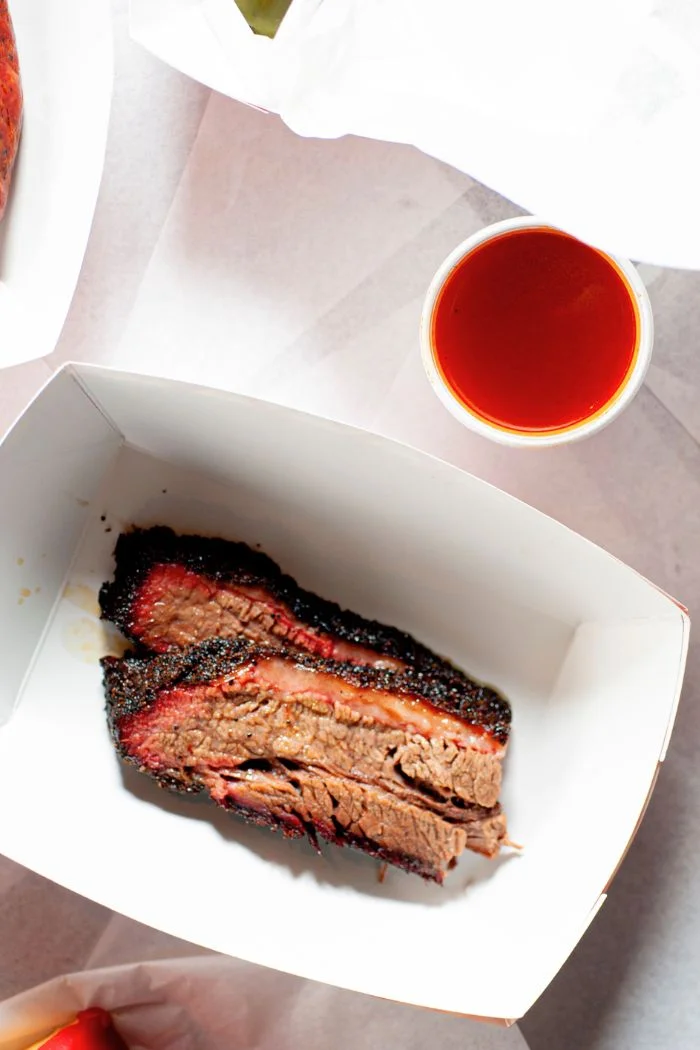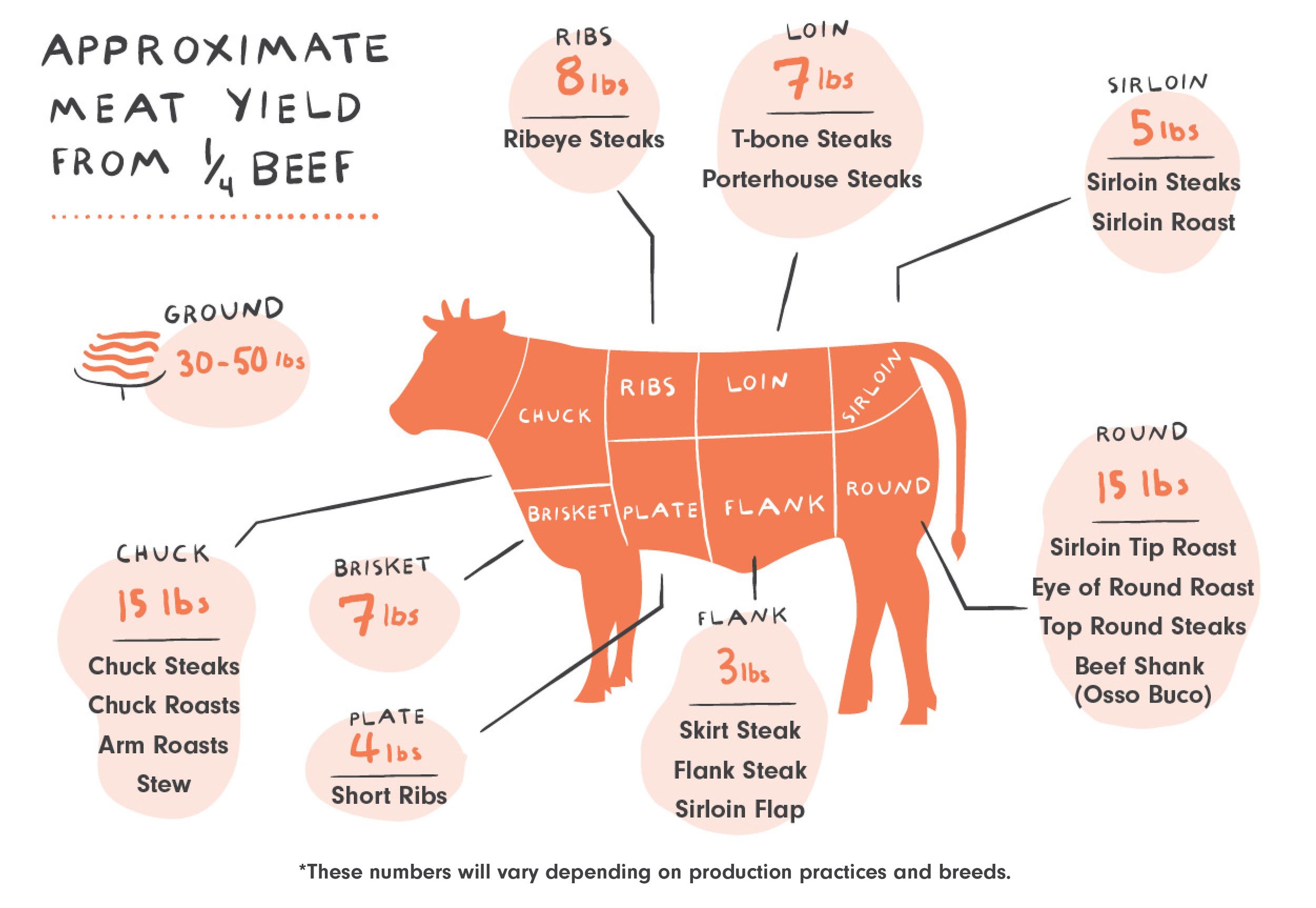Understanding Beef Brisket And Yield

Beef Brisket refers to a cut of meat from the chest of a cow, known for its rich flavor and tenderness. It is a popular choice for barbecuing and smoking due to the high amount of connective tissue, which breaks down during slow cooking, resulting in a moist and flavorful dish. The yield of beef brisket per cow can vary depending on various factors such as the size of the brisket and the cattle breed. In this section, we will explore the factors that affect brisket yield and the recommended portion sizes for different cuts of beef brisket.
Beef Brisket: Definition And Cuts
Beef brisket is a cut of meat from the chest of a cow and is known for its rich flavor and tenderness. It is part of the nine primal cuts of beef and is highly valued for its culinary profile. Brisket can be divided into different cuts, including the full brisket, flat, and point cuts. The full brisket refers to the whole cut, while the flat cut is leaner and better suited for slicing. The point cut has more marbling and is often used for chopped or shredded dishes. Each cut offers a unique texture and flavor experience when cooked properly.
Yield Of Beef Brisket Per Cow
The yield of beef brisket per cow is limited to two briskets, with one coming from each side of the lower chest. This means that for every cow, there are two brisket muscles available. However, it’s important to note that the weight of each brisket can vary, ranging from 8-20 pounds. The majority of the brisket is made up of the flat cut, which typically weighs between 3-10 pounds. Considering that brisket only makes up around 4% of the entire carcass weight, its yield is relatively low compared to other cuts.
Factors Affecting Brisket Yield

There are several factors that can affect the yield of brisket from a cow. One key factor is the size of the brisket itself, as it can vary in weight from 8-20 pounds. Additionally, the breed of cattle can also impact the portion sizes, as different breeds may have different size and muscle structures. Another factor to consider is the cooking method used, as longer smoking times can result in more tender and flavorful brisket, but may also cause some shrinkage. It’s important to take these factors into account when estimating brisket yields and portion sizes.
Variations In Brisket Size
The size of a beef brisket can vary significantly, ranging from 8 to 20 pounds. This variation in size is due to factors such as the age and size of the bovine, as well as the genetic characteristics of the breed. Larger breeds of cattle tend to produce larger briskets, while smaller breeds may yield smaller cuts. Additionally, factors such as the animal’s diet and exercise level can also influence the size of the brisket. It is important to consider these variations when estimating yields and portion sizes for brisket cuts.
Impacts Of Cattle Breed On Brisket Portions
The breed of cattle can have a significant impact on the portion sizes of brisket cuts. Different cattle breeds have varying genetic characteristics and body structures, which can result in variations in the size and shape of their briskets. Larger breeds, such as Angus and Hereford, tend to produce larger briskets compared to smaller breeds like the Jersey. The composition of the brisket, including the amounts of fat and lean meat, can also vary depending on the breed. When estimating yields and portion sizes for brisket cuts, it is important to consider the specific breed of cattle being used.
Portion Sizes And Cuts

When it comes to portion sizes and cuts of beef brisket, there are various options to consider. Different cuts can be made from a single brisket, each offering its own unique characteristics and flavors. Common cuts include the point and flat, which are often separated to create versatile portions. The size of the portions can vary depending on personal preference and the desired cooking method. It is recommended to slice brisket against the grain to maximize tenderness and create bite-sized portions. Different recipes and cuisines may also call for specific portion sizes, so it is important to consider these factors when preparing and serving brisket.
Different Cuts From Beef Brisket
Beef brisket can be divided into different cuts, each offering its own unique characteristics and flavors. The two main cuts are the point and the flat. The flat, also known as the “first cut,” is leaner and more uniform in shape. It is often used for slicing and is perfect for sandwiches or serving as a main dish. The point, also known as the “second cut,” is fattier and has more marbling. It is usually used for making burnt ends, which are deliciously tender and flavorful. Both cuts can be prepared in various ways, such as smoking, braising, or roasting, to bring out their best qualities.
Recommended Portion Sizes For Brisket
When it comes to serving brisket, the recommended portion size is about half a pound per person. This allows for a generous serving without overwhelming individuals with a large amount of meat. Keep in mind that this recommendation is for cooked brisket. For uncooked brisket, it is best to calculate about one pound per person, taking into account the moisture loss during cooking. By following these portion guidelines, you can ensure that everyone gets a satisfying serving of tender and flavorful brisket.
Calculating Brisket Portions

When it comes to calculating brisket portions, there are a few factors to consider. First, determine the number of servings you need. This will depend on the number of guests you have. Next, decide on the portion size. Typically, a serving size for brisket is about half a pound per person. Finally, take into account the yield after cooking. Keep in mind that brisket tends to have around 50% yield after trimming and cooking. By considering these factors, you can accurately calculate how many briskets you will need to satisfy your guests.
Determining Brisket Portions Per Cow
Determining the number of brisket portions you can get from a cow depends on various factors. Typically, each cow has one brisket weighing between 12 and 16 pounds. To calculate the number of portions, you need to consider the desired portion size and the yield after cooking. A serving size for brisket is usually about half a pound per person. Additionally, keep in mind that brisket has approximately a 50% yield after trimming and cooking. By taking these factors into account, you can determine the number of brisket portions you can expect from each cow.
Methods For Estimating Brisket Yields
There are several methods for estimating brisket yields in order to determine the number of portions per cow. One common method is to use the average weight of a whole brisket and calculate the yield based on the desired portion size. Another approach is to use data from previous brisket yields to estimate the yield for a specific cow. Additionally, utilizing specialized software or consulting with experts in the field can provide more accurate estimations. It is important to consider these methods when planning brisket portions to ensure proper portioning and avoid wastage.
Utilization Of Brisket Cuts

One of the most popular ways to utilize brisket cuts is by smoking or roasting them to achieve tender and flavorful meat. Brisket is commonly used in dishes such as barbecue brisket, braised brisket, and corned beef. It can also be sliced and served as deli meat or used as a filling in sandwiches and tacos. Additionally, brisket can be diced and added to stews or chili for added texture and richness. The versatility of brisket cuts allows for endless culinary possibilities, making it a favorite among meat lovers and chefs alike.
Popular Dishes And Cooking Methods
One of the most popular ways to utilize brisket cuts is by smoking or roasting them to achieve tender and flavorful meat. Brisket is commonly used in dishes such as barbecue brisket, braised brisket, and corned beef. It can also be sliced and served as deli meat or used as a filling in sandwiches and tacos. Additionally, brisket can be diced and added to stews or chili for added texture and richness. The versatility of brisket cuts allows for endless culinary possibilities, making it a favorite among meat lovers and chefs alike.
Best Practices For Preparing Brisket
When preparing brisket, there are several best practices to follow for optimal results. First, it is important to properly trim the brisket to remove excess fat and silver skin, as this can improve the tenderness of the meat. Additionally, seasoning the brisket with a dry rub or marinade and allowing it to marinate for at least a few hours, or even overnight, can enhance the flavor. When cooking, low and slow is the key. Brisket is best cooked at a low temperature (around 225-250°F) for a long period of time to ensure tender and juicy meat. Finally, allowing the brisket to rest for at least 30 minutes after cooking will help retain its juices and make slicing easier. By following these best practices, you can achieve a delicious and mouthwatering brisket every time.
Conclusion

In conclusion, understanding the yield and portions of beef brisket per cow is crucial for cattle producers and consumers alike. By exploring factors such as brisket size, cattle breed, and cooking methods, one can accurately determine the number of briskets per cow and make informed decisions about portioning and utilization. It is important to note that yield can vary based on individual circumstances, but with the right knowledge and best practices for preparing brisket, delicious and flavorful results can be achieved. Whether enjoying a tender brisket at a BBQ or serving it in various dishes, a thorough understanding of brisket yield is essential.
Summary Of Brisket Yields And Portions
Understanding the yields and portions of beef brisket per cow is crucial for both producers and consumers. Each cow yields two briskets, which are located in the chest and highly used muscle groups. The size of the brisket can vary, but it is typically a large cut of meat. Factors such as cattle breed and cooking methods can also affect the portion sizes and yields. It is important to properly portion and utilize the brisket, whether it is served as a whole cut, sliced into different portions, or used in various dishes.
Key Takeaways And Recommendations For Handling Brisket Cuts
When it comes to handling brisket cuts, here are some key takeaways and recommendations to keep in mind. First, consider the size and yield of the brisket, as it can vary depending on factors such as cattle breed and cooking methods. Second, understand the different cuts that can be made from the brisket, including the flat and the point. Third, make sure to properly portion and utilize the brisket, whether it is served as a whole cut, sliced into portions, or used in various dishes. Lastly, follow best practices for preparing brisket to ensure a flavorful and tender result. By following these recommendations, you can make the most out of your brisket cuts.
FAQ About “how Many Briskets Per Cow: Exploring Yield And Portions In Beef Cuts”
Q: What is the typical yield of briskets from a single cow?
A: On average, a cow produces around 2 briskets. However, this can vary depending on the size and weight of the cow.
Q: How many portions can be obtained from a single brisket?
A: A single brisket can typically yield around 12-14 portions, depending on the portion size and cooking method.
Q: What is the recommended serving size for brisket portions?
A: A standard serving size for brisket is around 4-6 ounces per person. This may vary based on individual preferences and recipes.
Q: Are there different types of brisket cuts available from a cow?
A: Yes, brisket can be divided into different cuts such as the flat cut or the point cut. Each cut has its own unique texture and flavor profile.
Q: What are some popular cooking methods for preparing brisket?
A: Brisket can be cooked using methods such as smoking, braising, or slow roasting. Each method results in a distinct taste and tenderness of the meat.
Q: How can I ensure the tenderness of the brisket when cooking?
A: To ensure a tender brisket, it is recommended to cook it low and slow, allowing the collagen in the meat to break down and tenderize over time. Using a meat thermometer to monitor internal temperature is also crucial for a perfectly cooked brisket.
Q: Are there any alternative cuts or substitutes for brisket?
A: If brisket is not readily available, cuts like chuck roast or short ribs can be used as substitutes for a similar flavor and texture in recipes.
Q: What are some popular seasoning and marinade options for enhancing the flavor of brisket?
A: Seasonings such as salt, pepper, garlic powder, and paprika are commonly used to enhance the flavor of brisket. Marinades with ingredients like soy sauce, Worcestershire sauce, and brown sugar can also add depth to the taste profile of the meat.

Johnny Knuckles Knock-out BBQ is a culinary haven for barbecue enthusiasts, offering a fusion of traditional BBQ and tantalizing street fare. Our secret to delivering mouthwatering dishes lies in our meticulous preparation process. Each cut of meat is lovingly hand-rubbed and slow-smoked over 100% hardwood, creating a symphony of flavors that will leave your taste buds dancing. Whether planning a special event or simply craving an unforgettable meal, Johnny Knuckles Knock-out BBQ is here to elevate your dining experience. Our catering services are designed to bring the sizzle and aroma of our delectable BBQ to your event, ensuring that every guest leaves with a full belly and a smile.